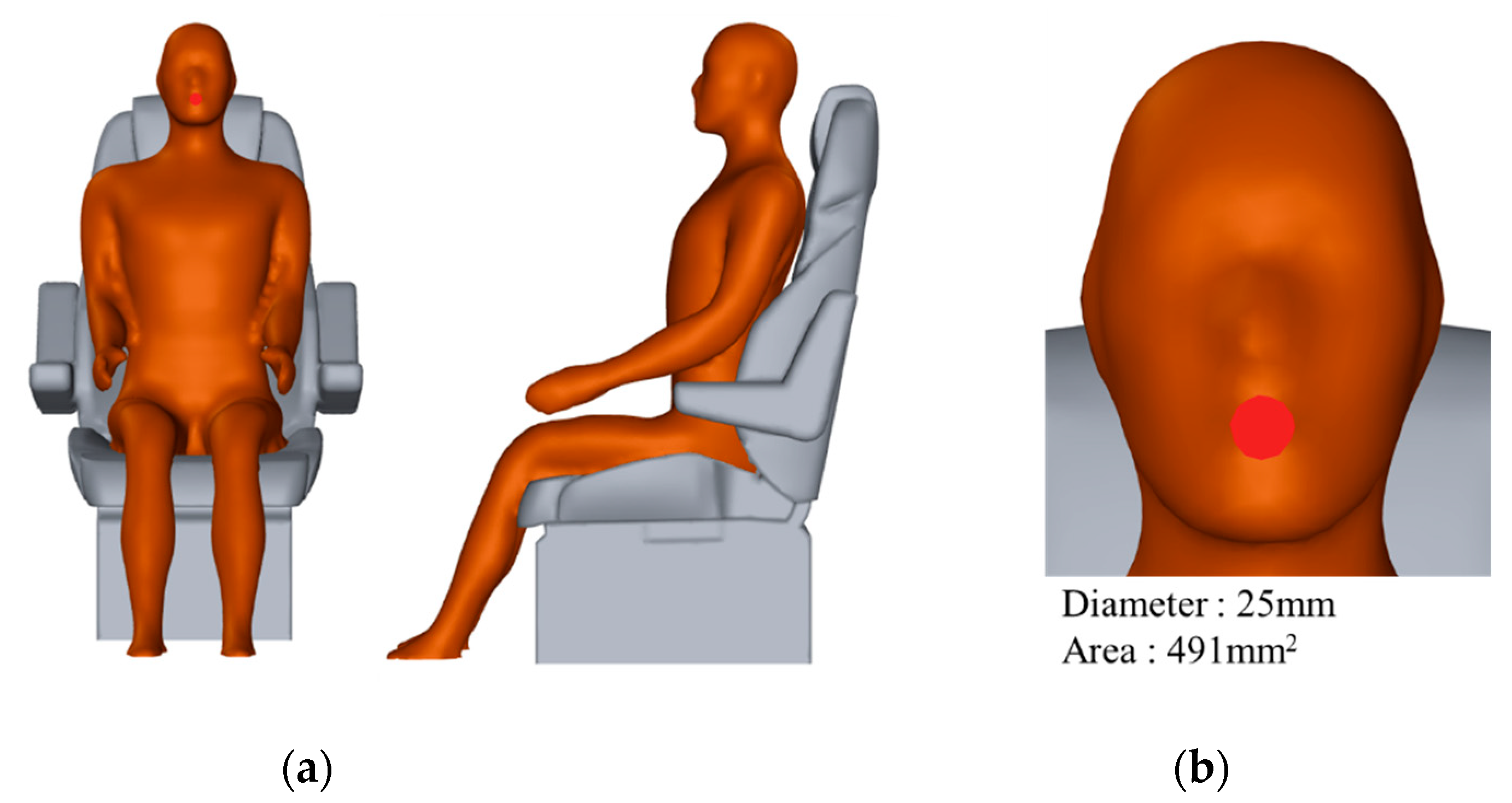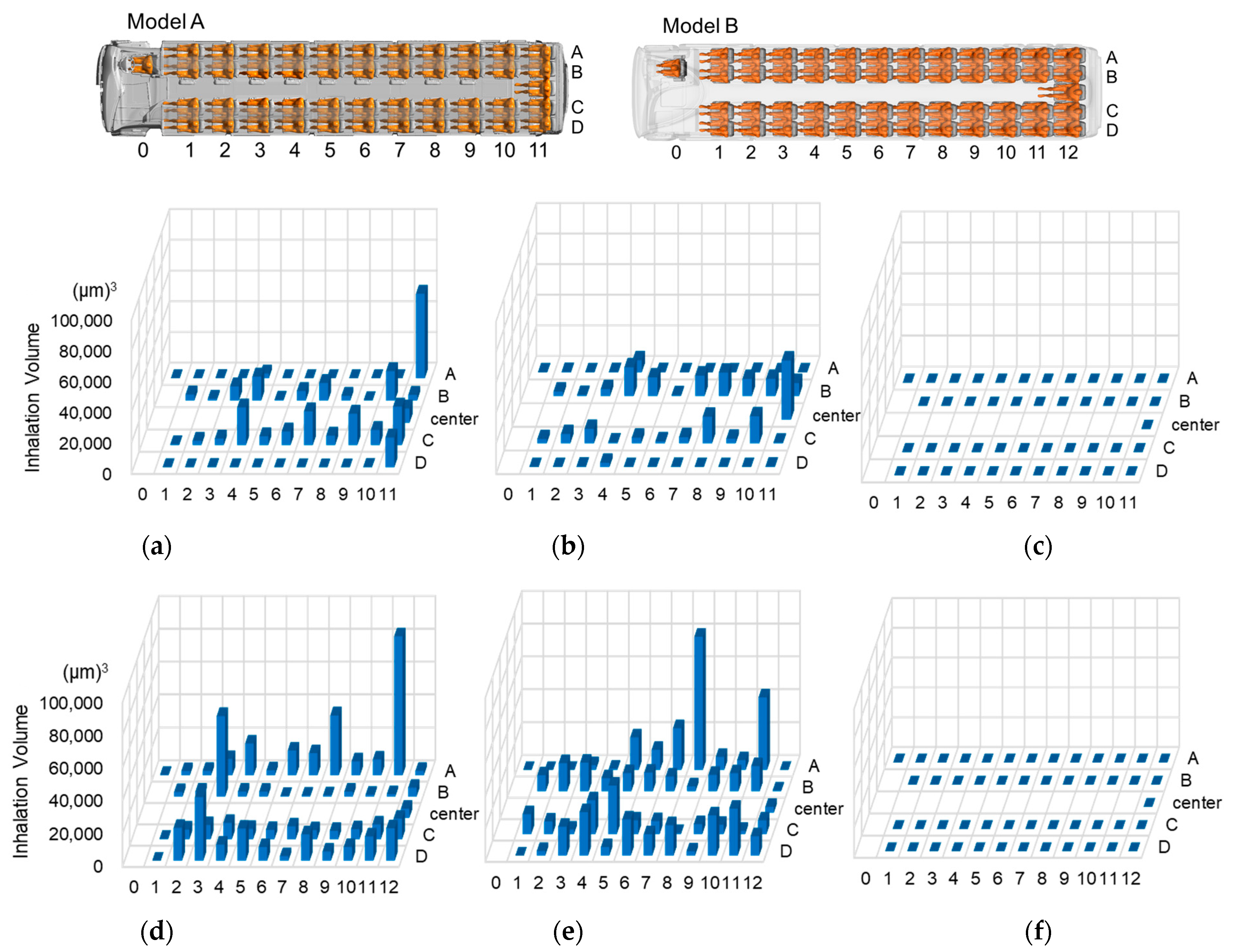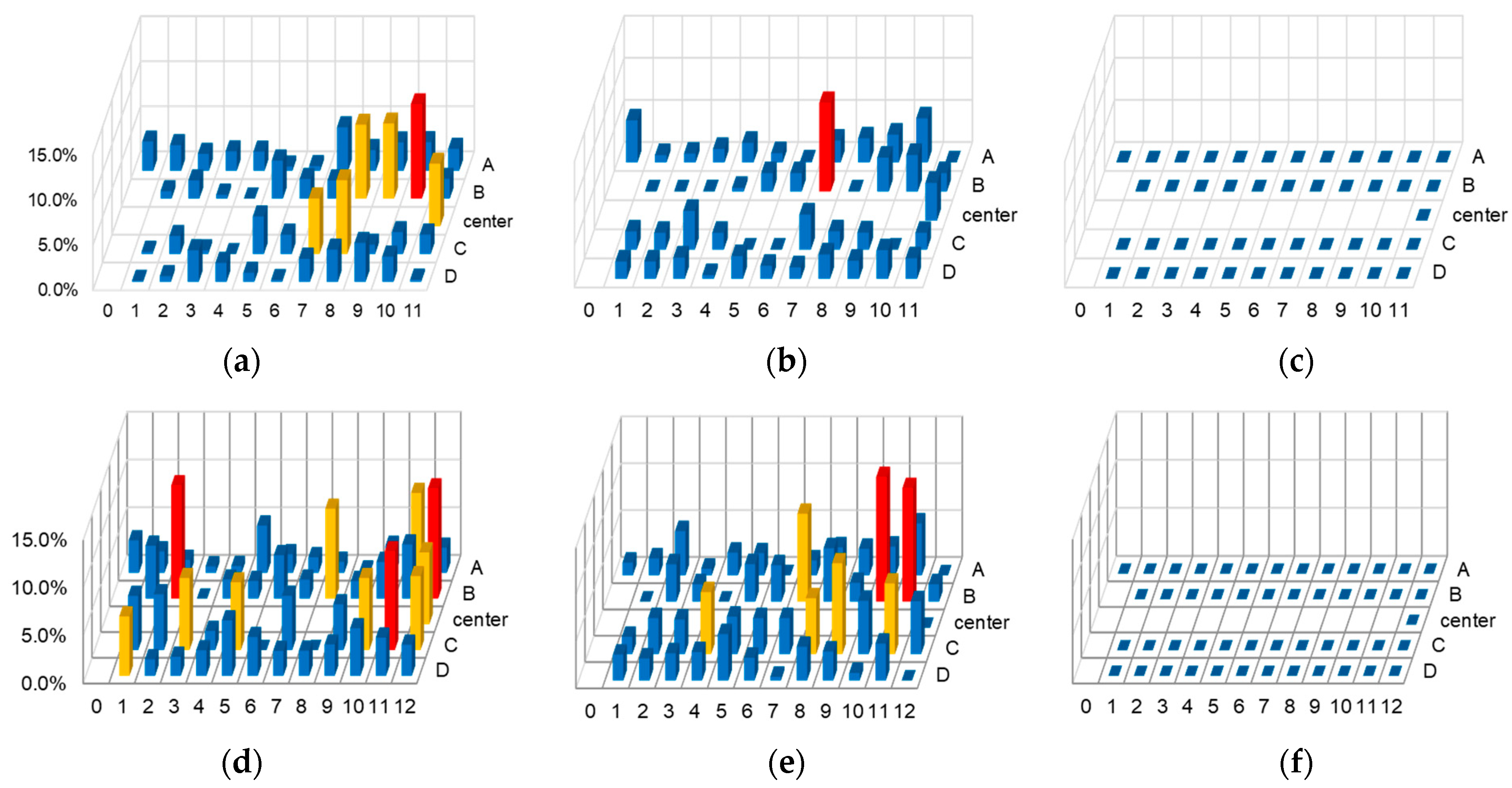Computational Fluid and Particle Dynamics Analyses for Prediction of Airborne Infection/Spread Risks in Highway Buses: A Parametric Study
Abstract
:1. Introduction
2. Materials and Methods
2.1. Bus Cabin Models
2.2. CSP
2.3. Airflow, Heat, Moisture, and Droplet Transport Analysis
2.4. Analytical and Boundary Conditions
3. Results and Discussions
4. Conclusions
Author Contributions
Funding
Data Availability Statement
Conflicts of Interest
References
- Bagshaw, M.; Illig, P. The Aircraft Cabin Environment. In Travel Medicine; Elsevier: Amsterdam, The Netherlands, 2019; pp. 429–436. [Google Scholar]
- Shek, K.W.; Wai, T.C. Combined comfort model of thermal comfort and air quality on buses in Hong Kong. Sci. Total Environ. 2008, 389, 277–282. [Google Scholar] [CrossRef]
- Praml, G.; Schierl, R. Dust exposure in Munich public transportation: A comprehensive 4-year survey in buses and trams. Int. Arch. Occup. Environ. Health 2000, 73, 209–214. [Google Scholar] [CrossRef]
- Chan, A.T. Commuter exposure and indoor–outdoor relationships of carbon oxides in buses in Hong Kong. Atmos. Environ. 2003, 37, 3809–3815. [Google Scholar] [CrossRef]
- Chan, L.Y.; Lau, W.L.; Zou, S.C.; Cao, Z.X.; Lai, S.C. Exposure level of carbon monoxide and respirable suspended particulate in public transportation modes while commuting in urban area of Guangzhou, China. Atmos. Environ. 2002, 36, 5831–5840. [Google Scholar] [CrossRef]
- Guevara-Luna, M.; Belalcazar, L.; Guevara Luna, F. CFD Modeling and Validation of Tracer Gas Dispersion to Evaluate Self-Pollution in School Buses. Asian J. Atmos. Environ. 2019, 13, 1–10. [Google Scholar] [CrossRef]
- Zhu, S.; Demokritou, P.; Spengler, J. Experimental and numerical investigation of micro-environmental conditions in public transportation buses. Build. Environ. 2010, 45, 2077–2088. [Google Scholar] [CrossRef]
- Wang, C.; Yoo, S.-J.; Ito, K. Does detailed hygrothermal transport analysis in the respiratory tract affect skin surface temperature distributions using a thermoregulation model? Adv. Build. Energy Res. 2020, 14, 450–470. [Google Scholar] [CrossRef]
- Sorensen, D.N.; Nielsen, P.V. Quality control of computational fluid dynamics in indoor environments. Indoor Air 2003, 13, 2–17. [Google Scholar] [CrossRef]
- Xing, H.; Hatton, A.; Awbi, H.B. A study of the air quality in the breathing zone in a room with displacement ventilation. Build. Environ. 2001, 36, 809–820. [Google Scholar] [CrossRef]
- Brohus, H. Personal Exposure to Contaminant Sources in Ventilated Rooms. Ph.D. Thesis, Aalborg University, Aalborg, Denmark, 1997. [Google Scholar]
- Brohus, H.; Balling, K.D.; Jeppesen, D. Influence of movements on contaminant transport in an operating room. Indoor Air 2006, 16, 356–372. [Google Scholar] [CrossRef]
- Murakami, S.; Zeng, J. Flow and temperature fields around human body with various room air distributions, Part 1—CFD study on computational thermal manikin. AHSRAE Trans. 1997, 103, 3–15. [Google Scholar]
- Murakami, S.; Kato, S.; Zeng, J. Combined simulation of airflow, radiation and moisture transport for heat release from human body. Build. Environ. 2000, 35, 489–500. [Google Scholar] [CrossRef]
- Topp, C.; Nielsen, P.V.; Sørensen, D.N. Application of Computer-Simulated Persons in Indoor Environmental Modeling. ASHRAE Trans. 2002, 108 Pt 2, 2002. [Google Scholar]
- Gao, N.P.; Zhang, H.; Niu, J.L. Investigating indoor air quality and thermal comfort using a numerical thermal manikin. Indoor Built Environ. 2007, 16, 7–17. [Google Scholar] [CrossRef]
- Kuga, K.; Wargocki, P.; Ito, K. Breathing zone and exhaled air re-inhalation rate under transient conditions assessed with a computer-simulated person. Indoor Air 2022, 32, e13003. [Google Scholar] [CrossRef]
- Kuga, K.; Ito, K.; Chen, W.; Wang, P.; Kumagai, K. A numerical investigation of the potential effects of e-cigarette smoking on local tissue dosimetry and the deterioration of indoor air quality. Indoor Air 2020, 30, 1018–1038. [Google Scholar] [CrossRef]
- Murota, K.; Kang, Y.; Hyodo, S.; Yoo, S.-J.; Takenouchi, K.; Tanabe, S.; Ito, K. Hygro-thermo-chemical transfer analysis of clothing microclimate using three-dimensional digital clothing model and computer-simulated person. Indoor Built Environ. 2022, 31, 1493–1510. [Google Scholar] [CrossRef]
- Ito, K. In silico human model for fluid-initiated indoor environmental design. Indoor Built Environ. 2017, 26, 295–297. [Google Scholar] [CrossRef]
- Yoo, S.-J.; Ito, K. Assessment of Transient Inhalation Exposure using in silico Human Model integrated with PBPK–CFD Hybrid Analysis. Sustain. Cities Soc. 2018, 40, 317–325. [Google Scholar] [CrossRef]
- Yoo, S.-J.; Ito, K. Numerical Prediction of Tissue Dosimetry in Respiratory Tract using Computer Simulated Person integrated with physiologically based pharmacokinetic (PBPK)-computational fluid dynamics (CFD) Hybrid Analysis. Indoor Built Environ. 2018, 27, 877–889. [Google Scholar] [CrossRef]
- Yoo, S.-J.; Ito, K. Multi-stage optimization of local environmental quality by comprehensive computer simulated person as a sensor for HVAC control. Adv. Build. Energy Res. 2019, 14, 171–188. [Google Scholar] [CrossRef]
- Ito, K. Toward the development of an in silico human model for indoor environmental design. Proc. Jpn. Acad. Ser. B 2016, 92, 185–203. [Google Scholar] [CrossRef]
- Fanger, P.O. Thermal Comfort; McGraw-Hill Inc.: New York, NY, USA, 1973. [Google Scholar]
- Menter, F.R.; Kuntz, M.; Langtry, R. Ten years of Industrial experience with the SST turbulence model. In Turbulence, Heat and Mass Transfer; Hanjalic, K., Nagano, Y., Tummers, M., Eds.; Begell House, Inc.: Danbury, CT, USA, 2003; p. 625e632. [Google Scholar]
- Yan, Y.; Li, X.; Ito, K. Numerical investigation of indoor particulate contaminant transport using the Eulerian-Eulerian and Eulerian–Lagrangian two-phase flow models. Exp. Comput. Multiph. Flow 2019, 2, 31–40. [Google Scholar] [CrossRef]
- Clift, R.; Grace, J.; Weber, M.E. Bubbles, Drops, and Particles; Dover Publications, Inc.: Mineola, NY, USA, 2005. [Google Scholar]
- ANSYS/Fluent. 15 User’s Guide; ANSYS, Inc.: Canonsburg, PA, USA, 2013. [Google Scholar]
- Xie, X.; Li, Y.; Sun, H.; Liu, L. Exhaled droplets due to talking and coughing. J. R. Soc. Interface 2009, 6 (Suppl. S6), 703–714. [Google Scholar] [CrossRef]
- Nicas, M.; Nazaroff, W.W.; Hubbard, A. Toward Understanding the Risk of Secondary Airborne Infection: Emission of Respirable Pathogens. J. Occup. Environ. Hyg. 2005, 2, 143–154. [Google Scholar] [CrossRef]
- Simha, P.P.; Rao, P.S.M. Universal trends in human cough airflows at large distances. Phys. Fluids 2020, 32, 081905. [Google Scholar] [CrossRef] [PubMed]
- Yoo, S.; Ito, K. Validation, verification, and quality control of computational fluid dynamics analysis for indoor environments using a computer-simulated person with respiratory tract. Jpn. Archit. Rev. 2022, 5, 714–727. [Google Scholar] [CrossRef]
- Foat, T.G.; Parker, S.T.; Castro, I.P.; Xie, Z.-T. Numerical investigation into the structure of scalar plumes in a simple room. J. Wind Eng. Ind. Aerodyn. 2018, 175, 252–263. [Google Scholar] [CrossRef]
- Nielsen, P.V. Specification of a two-dimensional test case. In IEA; Institut for Bygningsteknik, Aalborg Universitet: Aalborg, Denmark, 1990; Volume 1, p. R9040. [Google Scholar]
- Nielsen, P.V. Fifty years of CFD for room air distribution. Build. Environ. 2015, 91, 78–90. [Google Scholar] [CrossRef]
- Ito, K.; Inthavong, K.; Kurabuchi, T.; Ueda, T.; Endo, T.; Omori, T.; Ono, H.; Kato, S.; Sakai, K.; Suwa, Y.; et al. CFD benchmark tests for indoor environmental problems: Part 1 isothermal/non-isothermal flow in 2D and 3D room model. J. Archit. Eng. Technol. 2015, 2, 1–22. [Google Scholar]
- Ito, K.; Inthavong, K.; Kurabuchi, T.; Ueda, T.; Endo, T.; Omori, T.; Ono, H.; Kato, S.; Sakai, K.; Suwa, Y.; et al. CFD benchmark tests for indoor environmental problems: Part 4 air-conditioning airflows, residential kitchen airflows and fire-induced flow. J. Archit. Eng. Technol. 2015, 2, 76–102. [Google Scholar]
- Ito, K.; Inthavong, K.; Kurabuchi, T.; Ueda, T.; Endo, T.; Omori, T.; Ono, H.; Kato, S.; Sakai, K.; Suwa, Y.; et al. CFD benchmark tests for indoor environmental problems: Part 3 numerical thermal manikins. J. Archit. Eng. Technol. 2015, 2, 50–75. [Google Scholar]
- Ito, K.; Inthavong, K.; Kurabuchi, T.; Ueda, T.; Endo, T.; Omori, T.; Ono, H.; Kato, S.; Sakai, K.; Suwa, Y.; et al. CFD benchmark tests for indoor environmental problems: Part 2 cross-ventilation airflows and floor heating systems. J. Archit. Eng. Technol. 2015, 2, 23–49. [Google Scholar]
- Lee, M.; Park, G.; Park, C.; Kim, C. Improvement of Grid Independence Test for Computational Fluid Dynamics Model of Building Based on Grid Resolution. Adv. Civ. Eng. 2020, 2020, 8827936. [Google Scholar] [CrossRef]
- Nielsen, P.V.; Murakami, S.; Kato, S.; Topp, C.; Yang, J.-H. Benchmark Tests for a Computer Simulated Person; Indoor Environmental Engineering, Aalborg University: Aalborg, Denmark, 2003. [Google Scholar]
- Kobayashi, H.; Kato, S.; Murakami, S. Scales for evaluating ventilation efficiency as affected by supply and exhaust openings based on spatial distribution of contaminant by means of numerical simulation. Trans. Soc. Heat. Air Cond. Sanit. Eng. Jpn. 1998, 23, 29–36. [Google Scholar]
- Buonanno, G.; Morawska, L.; Stabile, L. Quantitative assessment of the risk of airborne transmission of SARS-CoV-2 infection: Prospective and retrospective applications. Environ. Int. 2020, 145, 106112. [Google Scholar] [CrossRef]
- Buonanno, G.; Stabile, L.; Morawska, L. Estimation of airborne viral emission: Quanta emission rate of SARS-CoV-2 for infection risk assessment. Environ. Int. 2020, 141, 105794. [Google Scholar] [CrossRef]
- Pan, Y.; Zang, D.; Yang, P.; Poon, L.M.; Wang, Q. Viral load of SARS-CoV-2 in clinical samples. Lancet Infect. Dis. 2020, 20, 411–412. [Google Scholar] [CrossRef] [PubMed]
- Puhach, O.; Adea, K.; Hulo, N.; Sattonnet, P.; Genecand, C.; Iten, A.; Jacquérioz, F.; Kaiser, L.; Vetter, P.; Eckerle, I.; et al. Infectious viral load in unvaccinated and vaccinated individuals infected with ancestral, Delta or Omicron SARS-CoV-2. Nat. Med. 2022, 28, 1491–1500. [Google Scholar] [CrossRef]
- Smith, C.E. A Transient, Three-Dimensional Model of the Human Thermal System. Ph.D. Thesis, Kansas State University, Manhattan, KS, USA, 1991. [Google Scholar]
- Stolwijk, J.A.J. A Mathematical Model of Physiological Temperature Regulation in Man; NASA Contractor Report; NASA: Washington, DC, USA, 1971. [Google Scholar]
- Fiala, D. Dynamic Simulation of Human Heat Transfer and Thermal Comfort. Sustain. Dev. 1998, 45, 1. [Google Scholar]
- Kobayashi, Y.; Tanabe, S. Development of JOS-2 human thermoregulation model with detailed vascular system. Build. Environ. 2013, 66, 1–10. [Google Scholar] [CrossRef]
- Yoo, S.-J.; Kurokawa, A.; Matsunaga, K.; Ito, K. Spatial distributions of airborne transmission risk on commuter buses: Numerical case study using computational fluid and particle dynamics with computer-simulated persons. Exp. Comput. Multiph. Flow 2023, 5, 304–318. [Google Scholar] [CrossRef] [PubMed]









| Inflow Boundary (HVAC) | Qin = 0.64 m3/s, Temperature: Tin = 21.3 °C, Humidity: φin = 50% RH |
| Wall treatment (cabin and partition) | Temperature and humidity: Adiabatic, Particle: trap |
| Wall treatment (CSP) | Heat generation: calculated by Fanger’s 1-node model |
| (Clothing: 0.57 clo = 0.088 m2 °C/W) | |
| Humidity: φskin = 0.01449 kg/kg’ | |
| Radiation heat transfer analysis | Short-wave: calculated by solar ray tracing method |
| Long-wave: calculated by Surface-to-surface(S2S) model | |
| Window properties: Absorptivity = 0.1, Transmissivity = 0.75 | |
| Cases analyzed | Case A1: Model A without partition |
| Case A2: Model A with partition | |
| Case A3: Model A without partition, mask-wearing | |
| Case B1: Model B without partition | |
| Case B2: Model B with partition | |
| Case B3: Model B without partition, mask-wearing |
| dpi [µm] | dpc [µm] | Number of Particles Generated (without Mask) | Number of Particles Generated (with Mask) |
|---|---|---|---|
| 20 | 5.24 | 30 | 42 |
| 36 | 9.43 | 50 | 27 |
| 45 | 11.8 | 620 | 96 |
| 62.5 | 16.4 | 3080 | 126 |
| 87.5 | 22.9 | 2340 | 0 |
| 112.5 | 29.5 | 1500 | 0 |
| 137.5 | 36 | 590 | 0 |
| 175 | 45.9 | 740 | 0 |
| 225 | 59 | 340 | 0 |
| 375 | 98.3 | 450 | 0 |
| 750 | 196.6 | 240 | 0 |
| 1500 | 393.1 | 20 | 0 |
Disclaimer/Publisher’s Note: The statements, opinions and data contained in all publications are solely those of the individual author(s) and contributor(s) and not of MDPI and/or the editor(s). MDPI and/or the editor(s) disclaim responsibility for any injury to people or property resulting from any ideas, methods, instructions or products referred to in the content. |
© 2023 by the authors. Licensee MDPI, Basel, Switzerland. This article is an open access article distributed under the terms and conditions of the Creative Commons Attribution (CC BY) license (https://creativecommons.org/licenses/by/4.0/).
Share and Cite
Yoo, S.-J.; Yamauchi, S.; Park, H.; Ito, K. Computational Fluid and Particle Dynamics Analyses for Prediction of Airborne Infection/Spread Risks in Highway Buses: A Parametric Study. Fluids 2023, 8, 253. https://doi.org/10.3390/fluids8090253
Yoo S-J, Yamauchi S, Park H, Ito K. Computational Fluid and Particle Dynamics Analyses for Prediction of Airborne Infection/Spread Risks in Highway Buses: A Parametric Study. Fluids. 2023; 8(9):253. https://doi.org/10.3390/fluids8090253
Chicago/Turabian StyleYoo, Sung-Jun, Shori Yamauchi, Hyungyu Park, and Kazuhide Ito. 2023. "Computational Fluid and Particle Dynamics Analyses for Prediction of Airborne Infection/Spread Risks in Highway Buses: A Parametric Study" Fluids 8, no. 9: 253. https://doi.org/10.3390/fluids8090253
APA StyleYoo, S.-J., Yamauchi, S., Park, H., & Ito, K. (2023). Computational Fluid and Particle Dynamics Analyses for Prediction of Airborne Infection/Spread Risks in Highway Buses: A Parametric Study. Fluids, 8(9), 253. https://doi.org/10.3390/fluids8090253






